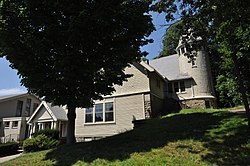
Naumkeag is the former country estate of noted New York City lawyer Joseph Hodges Choate and Caroline Dutcher Sterling Choate, located at 5 Prospect Hill Road, Stockbridge, Massachusetts. The estate's centerpiece is a 44-room, Shingle Style country house designed principally by Stanford White of McKim, Mead & White, and constructed in 1885 and 1886.
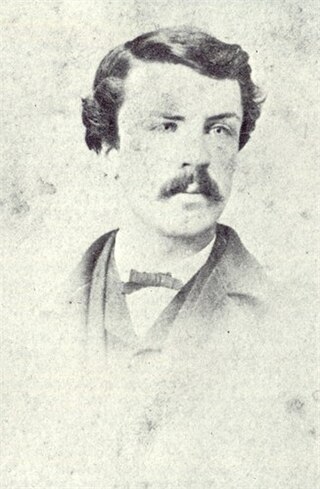
George Keller was an American architect and engineer. He enjoyed a diverse and successful career, and was sought for his designs of bridges, houses, monuments, and various commercial and public buildings. Keller's most famous projects, however, are the Soldiers and Sailors Memorial Arch in Hartford, Connecticut, and the James A. Garfield Memorial in Cleveland, Ohio.

The Congregational Library & Archives is an independent special collections library and archives. It is located on the second floor of the Congregational House at 14 Beacon Street in the Beacon Hill neighborhood of Boston, Massachusetts. The Library was founded in 1853 by a gathering of Congregational ministers and has since evolved into a professional library and archives that holds more than 250,000 items, predominantly focused on 18th to 21st century American Congregational history. The Library's reading room is free and open to the public for research but the Library's stacks are closed and book borrowing privileges are extended exclusively to members.

The Converse Memorial Library – also known as Converse Memorial Building – is a historically significant building designed by noted American architect Henry Hobson Richardson. From 1885 to 1996, it housed the Malden Public Library, which now occupies a modern building adjacent to it. The former library is located at 36 Salem Street, Malden, Massachusetts.

Los Angeles Nurses' Club is a clubhouse and apartment building for nurses located in the Westlake district of Central Los Angeles, California.
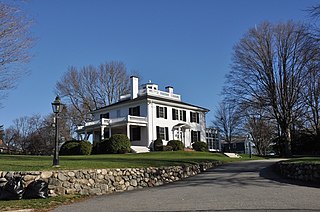
Beebe Homestead, also known as the Lucius Beebe House and Beebe Farm, is a historic Federal period home at 142 Main Street in Wakefield, Massachusetts, which was built during the federal era that extended from the late 18th-century into the 1820s. It is suspected to have been remodeled into the federal style from an earlier home built in circa 1727. It overlooks Lake Quannapowitt, and according to a 1989 study of historic sites in Wakefield, the house is "one of Wakefield's most imposing landmarks." The property was added to the National Register of Historic Places in 1989.

The Common District encompasses the main civic center of Wakefield, Massachusetts. It is centered on the historic town common, just south of Lake Quannapowitt, which was laid in 1644, when it became the heart of Old Reading. The area was separated from Reading as South Reading in 1818, and renamed Wakefield in 1868. The 25 acre district includes the buildings that line the common on Common Street and Main Street, which include the town hall, public library, YMCA, post office, and several churches. It was listed on the National Register of Historic Places in 1990.

The House at 6 Adams Street in Wakefield, Massachusetts is one of the best examples of Shingle style architecture in the town. It was designed by Boston architect Robert Pote Wait and built in 1885–86 to be his own home. It was listed on the National Register of Historic Places in 1989.

The Main Street Historic District in Miles City, Montana comprises much of the central business district of the town, extending along Main Street roughly between Prairie Avenue and Fourth Street. It was listed as a historic district on the National Register of Historic Places in 1989.

Hartwell and Richardson was a Boston, Massachusetts architectural firm established in 1881, by Henry Walker Hartwell (1833–1919) and William Cummings Richardson (1854–1935). The firm contributed significantly to the current building stock and architecture of the greater Boston area. Many of its buildings are listed on the National Register of Historic Places.

Grace Church or Grace Episcopal Church is a historic Episcopal church located at 600 Cleveland Avenue in Plainfield, Union County, New Jersey, United States. It was added to the National Register of Historic Places on May 10, 2002, for its significance in architecture, art, and music from 1892 to 1930.

St. Luke's Hospital was a hospital building on a bluff overlooking downtown Davenport, Iowa, United States. It is listed on the Davenport Register of Historic Properties and the National Register of Historic Places. It has subsequently been torn down.
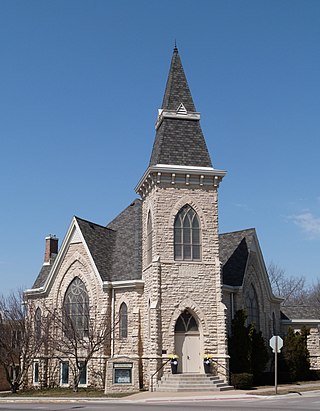
First Presbyterian Church is located in Marion, Iowa, United States. It was listed on the National Register of Historic Places in 1992.
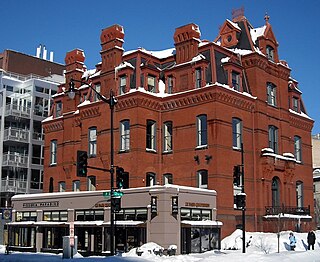
The James G. Blaine Mansion, commonly known as the Blaine Mansion, is a historic house located at 2000 Massachusetts Avenue NW, in the Dupont Circle neighborhood of Washington, D.C. The imposing house was completed in 1882 for James G. Blaine, a Republican politician from Maine who served as Speaker of the House, and later as a US Senator and US Secretary of State. He was also a presidential candidate who was narrowly defeated by Grover Cleveland in the 1884 United States presidential election.

The Oliver House, also known as the Smith-Oliver House, is a historic house at 58 Oak Street in Wakefield, Massachusetts. Probably built in the late 18th century, this Federal period house is distinctive for its association with the now-suburban area's agrarian past, and as a two-family residence of the period, with two "Beverly jogs". The house was listed on the National Register of Historic Places in 2014.

Holman K. Wheeler was a prolific Massachusetts architect. Wheeler is responsible for designing more than 400 structures in the city of Lynn alone, including the iconic High Rock Tower which is featured prominently on the Lynn city seal. While practicing in Lynn and Boston over a career spanning at least 35 years Wheeler designed structures throughout the Essex County area, including Haverhill, Marblehead, Newburyport, Salem, Swampscott, and Lynn. Wheeler is responsible for a total of five Lynn structures listed on the National Register of Historic Places, more than any other person or firm.

Roberts Park Methodist Episcopal Church, whose present-day name is Roberts Park United Methodist Church, was dedicated on August 27, 1876, making it one of the oldest church remaining in downtown Indianapolis. Diedrich A. Bohlen, a German-born architect who immigrated to Indianapolis in the 1850s, designed this early example of Romanesque Revival architecture. The church is considered one of Bohlen's major works. Constructed of Indiana limestone at Delaware and Vermont Streets, it has a rectangular plan and includes a bell tower on the southwest corner. The church is known for its interior woodwork, especially a pair of black-walnut staircases leading to galleries (balconies) surrounding the interior of three sides of its large sanctuary. The church was added to the National Register of Historic Places on August 19, 1982. It is home to one of several Homeless Jesus statues around the world, this one located behind the church on Alabama Street.
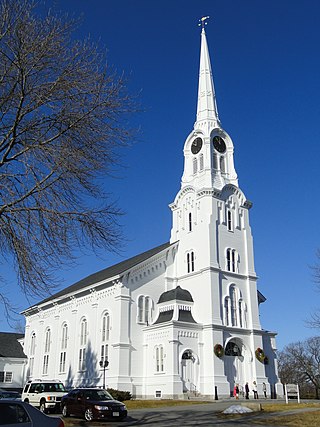
John Stevens (1824-1881) was an American architect who practiced in Boston, Massachusetts. He was known for ecclesiastical design, and designed churches and other buildings across New England.

The Courthouse Square Museum is a former government building, and current historical museum, located at 100 West Lawrence Avenue in Charlotte, Michigan. It was listed on the National Register of Historic Places in 1971.

Francis R. Richmond (1851-1907) was an American architect practicing in Springfield, Massachusetts.
